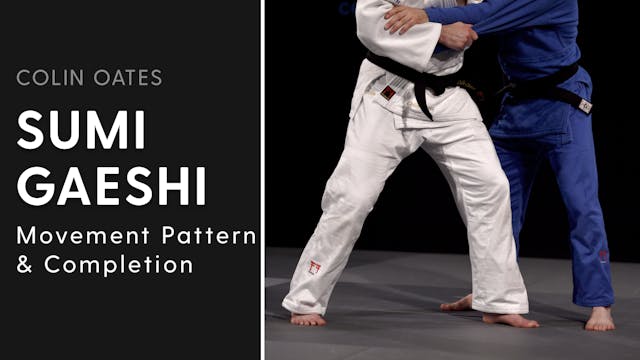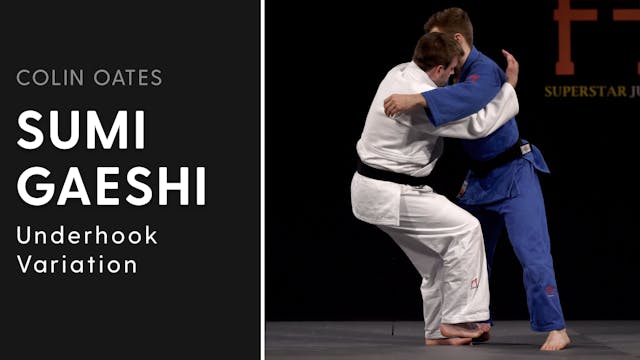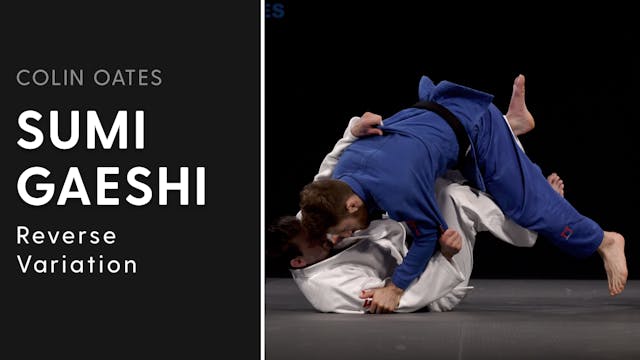Colin Oates, a left-handed fighter, uses Sumi gaeshi against right-handed opposition. For Oates’s Sumi gaeshi to be most effective both judoka need to be fully gripped up. So, he is quite happy to allow his partner to take the first grip on his jacket.
He then feeds his partner’s lapel into his left hand. The next step is a high cross grip with the right hand, before throwing the left arm around his partner’s back. He takes the lapel as high as he can, pulling in his partner, and taking a deep grip on the back of the jacket. This gives him the close control he needs to set up the attack.
Once they are in close quarters he releases the lapel and takes his partner’s sleeve. He prefers a high sleeve grip.
So here’s the gripping sequence in full. Oates points out that one of the most important details is to break the strength in Uke’s lapel grip. Here, he shows that the strength in the arm comes from the bicep. This means that his partner can keep him at a distance and prevent him from having the close control needed to execute Sumi gaeshi.
In order to break the strength in the arm Oates targets the elbow joint, but at an angle, he does this by folding the arm inwards and downwards and at the same time he feeds the lapel. This gripping technique gave him an advantage against even the strongest of opponents.
Once in position with the high lapel cross grip it’s extremely difficult for his partner to straighten their arm. With their arm folded, the back is presented. Oates says that it’s not important where he grips, as long as it’s deep. So he avoids the near shoulder.
As for the grip itself; he takes as much material of the jacket into his hand as possible, with the arm tight to the back. If he takes the near shoulder he gives his partner a chance to regain control of the situation, by stretching out their arm. So he must stay in control by going deep, and without hesitation. Generally, Oates likes to pin his opponent’s sleeve when in Kumi kata, but for Sumi gaeshi this isn’t ideal. He also doesn’t want Uke to have the upper sleeve grip.
Ideally, he’s looking to have the dominant sleeve grip, whilst his partner is gripped underneath - Oates now has an anchor. This allows him to pull in his partner and it’s this that breaks their posture and starts generating the momentum for his Sumi gaeshi. He says that if his partner doesn’t have a grip they will tend to step away from him as they don’t feel safe . He wants them to feel comfortable, so let’s them take the sleeve.
Up Next in Watch All
-
Movement Pattern & Completion | Sumi ...
Colin Oates regards his foot movement pattern as the single most important element to his Sumi gaeshi. He learnt this pattern from his Japanese coach, Go Tsunoda, which is traditionally used to set up the big forward or rear throws. Oates, however, managed to successfully incorporate it into Sumi...
-
Underhook Variation | Sumi Gaeshi | C...
Colin Oates’s underhook variation of Sumi gaeshi comes from when neither judoka has a sleeve grip. This technique evolved when Oates was chasing his opponent for the sleeve, but they were fighting hard not to give it up. As a result, momentum comes into play even more so than his standard variati...
-
Reverse Variation | Sumi Gaeshi | Col...
Colin Oates has an unusual reverse Sumi gaeshi, which perfectly compliments his standard variation of the technique. He learnt the reverse Sumi gaeshi from French World Champion Stephane Traineau early on in his career. However, he only incorporated into his judo several years later, but now cons...



